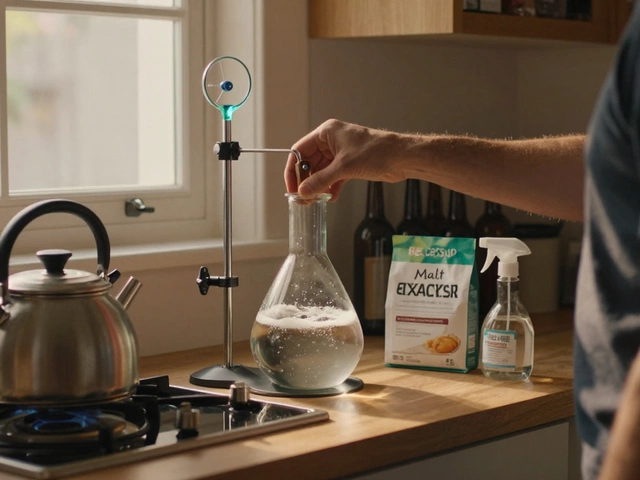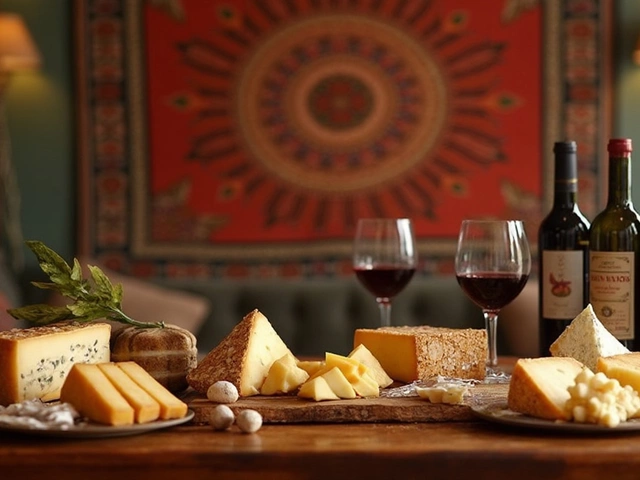
Building a wine and cheese board might seem like something only a master sommelier can do, but trust me, it's easier than you think. The trick is to balance flavors, textures, and presentation. Start with your cheeses: aim for variety. Have something firm, like aged cheddar or Manchego, something creamy such as Brie or Camembert, and a bit of blue like Gorgonzola for a punch. You don't need a hundred varieties; three to five is a solid range.
Next, you'll want to match those cheeses with complementary wines. For your aged cheddar, try a Cabernet Sauvignon. The robust flavors can handle the cheese's sharpness. That creamy Brie? A nice Chardonnay or even a dry sparkling wine can lift it beautifully. And for the blue cheese lovers, desserts wines like a Port or a Sauternes create a magical sweet-salty tango.
- Choosing the Right Cheeses
- Perfect Wine Pairings
- Add Delightful Extras
- Presentation Tips
- Things to Avoid
Choosing the Right Cheeses
Picking the right cheeses for your wine and cheese board can make or break the experience. You want a mix that provides different textures and flavor profiles. The goal is to keep your taste buds entertained, so variety is key!
Hard Cheeses
Hard cheeses are a must-have on your board. They offer a satisfying crunch and intensity. Think about including something like an aged Manchego or a good quality Parmigiano-Reggiano. These cheeses work well with wines having strong tannins like Chianti or Cabernet Sauvignon.
Soft and Creamy Cheeses
Now, to balance the hard, you need something soft and creamy. Brie and Camembert are classic picks. Their mild, buttery taste goes fantastically with a crisp white wine or a slightly bubbly Prosecco. If you’re feeling adventurous, a soft goat cheese adds a bit of tang.
Blue Cheeses
Not everyone loves blue cheese, but it’s a powerhouse for those who do. Gorgonzola or Stilton can be the star of your board. Their strong, salty flavors need a sweet counterpoint like a Port or a late harvest Riesling.
Additional Tips
- Include a cheese with a different milk base: cow, goat, and sheep, to offer distinct flavors.
- If you’re serving more than five people, plan on having about 2 ounces of cheese per person.
| Cheese Type | Ideal Wine Pair |
|---|---|
| Aged Manchego | Cabernet Sauvignon |
| Brie | Chardonnay |
| Gorgonzola | Port |
Don’t stress over having the ‘right’ cheese. Ultimately, what’s most important is that you and your guests enjoy the flavors. So remember to have fun with it!
Perfect Wine Pairings
Pairing wines with your cheese isn’t rocket science, but it's definitely worth a little thought. A general rule of thumb is to match the intensity of the cheese with the intensity of the wine. Don’t worry if you aren’t an expert; half the fun is trying new combinations!
White Wines
Chardonnay is a versatile choice. If you're serving something creamy like Brie or a buttery Havarti, a full-bodied Chardonnay can elevate those textures without overpowering the flavor. On the other hand, a Sauvignon Blanc with its crisp, citrusy notes works wonders with goat cheese, enhancing its tanginess without being too sharp.
Red Wines
For those richer, harder cheeses like aged cheddar or Gouda, reach for that Cabernet Sauvignon. It's bold enough to handle the cheese's robust flavors. Meanwhile, for a semi-hard cheese like a mild Asiago, you might find a Pinot Noir to be your best friend. Its light body and fruity aroma provide a wonderful counterpoint.
Sweet Wines
If blue cheese is on your board, don't shy away from a sweet wine like Port or Sauternes. These wines' sweetness can perfectly contrast with the saltiness of the cheese. Plus, the sweetness can tame the cheese’s sharp edges, making it more palatable for those new to blue cheeses!
Sparkling Wines
And let's not forget about bubbles. A dry sparkling wine or Champagne isn’t just for wedding toasts. It's great with almost any soft cheese and adds a festive touch to your wine and cheese board!
Here's a quick look at pairing suggestions:
| Cheese | Wine Suggestion |
|---|---|
| Brie | Chardonnay |
| Goat Cheese | Sauvignon Blanc |
| Blue Cheese | Port |
| Cheddar | Cabernet Sauvignon |
Remember, the ultimate goal is to enhance both the wine and the cheese without one overshadowing the other. Taste, experiment, and most importantly, have fun with your wine pairing journey!

Add Delightful Extras
Once you've nailed the main components of your wine and cheese board, it's time to have a bit of fun adding those little extras that make it pop. These aren't just fillers; they're little tidbits that bring out the best in your wine and cheese pairings.
Fruit and Nuts
Start with fresh fruits like grapes, strawberries, or apple slices. Fruits bring a natural sweetness and lightness that can cut through rich or salty cheeses. Dried fruits like apricots or figs are also great, especially when paired with strong cheeses like Gorgonzola. Nuts bring a satisfying crunch; try almonds, walnuts, or hazelnuts.
Charcuterie and Antipasti
If you want to take your board to the next level, charcuterie can be a great addition. Think prosciutto, salami, or even some chorizo. These meats add a savory element that pairs well with a variety of cheeses and wines. You could also include marinated olives, pickles, or artichokes to introduce some acidity and balance out the creamier textures.
Crunchy Bits
No wine and cheese board is complete without a selection of crackers or bread. Pick a mix of textures: a simple watercracker for a mild base, something seeded for added flavor, and maybe slices of a crusty baguette for that hearty touch. Don’t forget gluten-free options if you're hosting a diverse crowd.
Special Touches
If you're looking to really impress, consider adding honey, jams, or chutneys. Just a drizzle or a dollop can elevate the flavors of your cheeses. Honey pairs especially well with blue cheeses, while a fig jam complements Brie beautifully.
Ultimately, these extras are about enhancing the experience of your wine and cheese board. Plate them neatly but casually—think rustic but instagrammable—and let your guests decide how to mix and match.
Presentation Tips
Creating a stunning wine and cheese board is not just about taste; it's also about visual appeal. A beautifully arranged board can elevate your hosting game and make everything more inviting.
Use the Right Board
First things first, choose the right board. A wooden board gives a rustic vibe, while a marble slab adds elegance. Size matters too—big enough to hold everything but not so large that your treats get lost on it.
Arranging the Cheeses
Place your cheeses with a good mix of shapes and colors. Cut some cheese into slices or cubes and leave others whole for guests to slice themselves. This invites guests to dig in and explore. Keep your firmer cheeses on one side and softer ones on the other to prevent mixing of flavors.
Fill in the Gaps
Pick a mix of crispy crackers and freshly baked baguette slices. Try to nestle them between cheese or around the edges of the board. Little bowls of olives or nuts serve as delightful fillers without overpowering the centerpiece.
Enhance with Color
Add pops of color with fresh fruits or dried options. Grapes, apple slices, or figs are classic companions. Their sweetness can cleanse the palate between bites of cheese, prepping you for the next delicious taste.
Little Touches Matter
- Label your cheeses. A small tag or flag gives guests a heads-up on what they're eating.
- Don't stack items too high; a single layer lets your guests easily access every bite.
- Offer a variety of utensils, like cheese knives and spreaders, catering to different textures.
For a creative garnish, try edible flowers or fresh herbs. They add a touch of whimsy without affecting taste.
Table: Quick Pairing Guide
| Cheese | Wine |
|---|---|
| Cheddar | Cabernet Sauvignon |
| Brie | Chardonnay |
| Gorgonzola | Port |
Remember, a little planning and creativity goes a long way in making your wine and cheese board a memorable centerpiece.

Things to Avoid
While creating a delicious wine and cheese board, there are a few missteps you’ll want to sidestep. Avoiding these pitfalls ensures your board will be both stunning and satisfying.
Too Much Variety
Going overboard with variety can confuse the palate. Limit yourself to three to five cheeses. This number provides enough diversity without overwhelming your guests. The same goes for wines; a few well-chosen bottles will keep the experience enjoyable rather than chaotic.
Mismatching Flavors
Mixing flavors that clash is a common mistake. For instance, pairing a strong blue cheese with a delicate Pinot Grigio can drown out the wine’s subtle notes. Stick to pairs where neither element overpowers the other. Match bold cheeses with robust wines and mild cheeses with gentler wines.
Incorrect Temperatures
Serving wine and cheese at the wrong temperatures can dampen the experience. Cheese should sit out of the fridge long enough to lose its chill but not melt. Around 20 to 30 minutes usually does the trick. Red wines should be slightly cooler than room temperature, while whites and sparkling wines should be chilled but not icy.
Ignoring Allergies and Preferences
Be aware of common dietary restrictions and preferences. Having an option for those who are lactose intolerant or vegan is courteous and inclusive. Also, check if anyone has strong dislikes or allergies to certain cheeses or wines.
Poor Presentation
Your board should delight visually as much as it does taste-wise. A sloppy presentation can make even the best selection look unappealing. Place items thoughtfully and add color with fruit, nuts, or edible flowers for an attractive display.





Categories